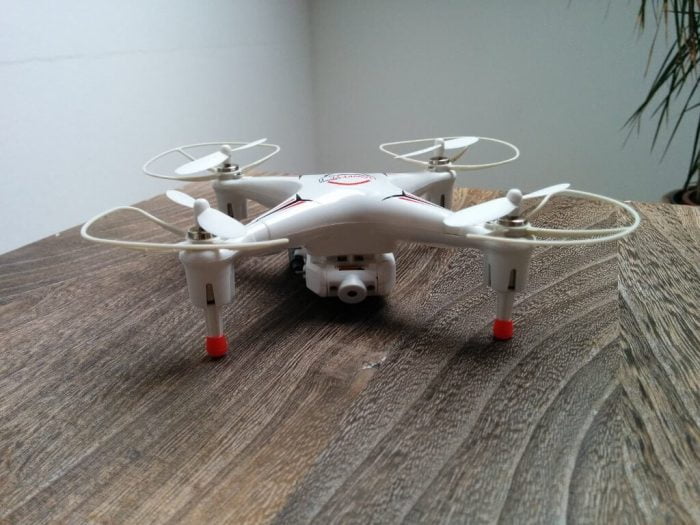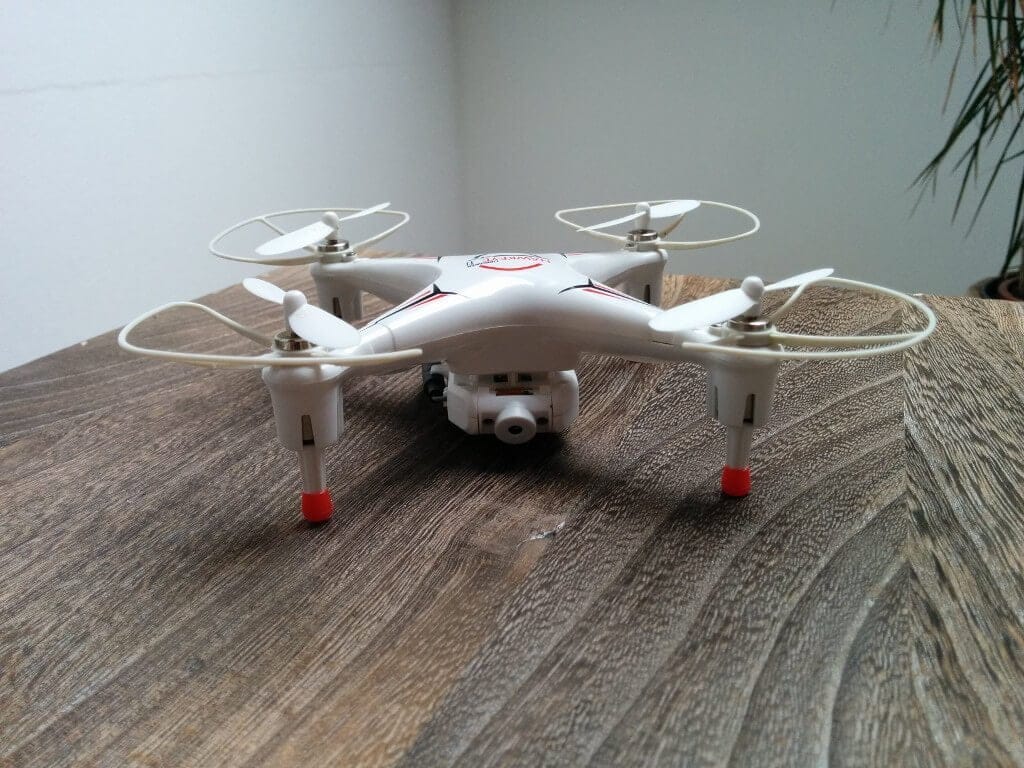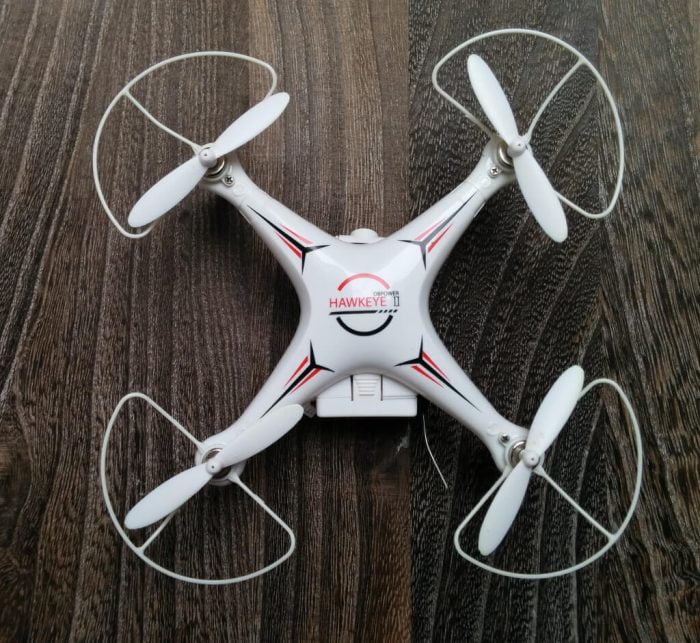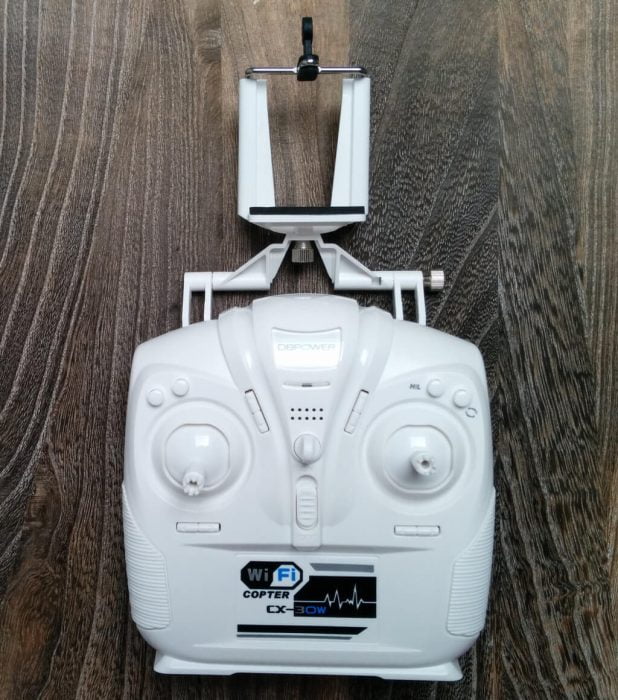DBPOWER
DBPOWER Hawkeye II Quadrocopter
* Function: forward, backward, up, down, left, right, flight sideways, hover, 360 ° rotation, throw to fly
* Remote Control Frequency: 2,4 GHz
* Remote Type: Radio Control and WIFI Control
* App: "CX-WIFIUFO"
* Remote control: Range: 30m
* WIFI image transmission range: 20M
* Flight time: 5-8min
* Charging time: 90min
* Battery: 1x rechargeable 3,7 V 700mAh Li-Po
* Transmitter battery: 4 x AA battery
* Suitable age: 14 +
* Hawkeye II
* Remote control with smartphone holder
* 4 spare rotors, 2 screwdrivers, a USB charging cable
* Operating instructions (English)
First impression of the DBPOWER Hawkeye-II
When I unpacked the Hawkeye-II quadrocopter, I first wondered about the rather barren delivery. In the box were the Quadrocopter, a remote control and a manual. I missed accessories, but as I looked closer at the packaging, I finally found a bag with 4 spare rotors, 2 screwdrivers and the charging cable. The bag was stuck very unfavorably on the underside of the plastic insert, so that it is hard to find.
The DBPOWER Hawkeye-II is approximately 15x15x5cm and has a removable WLAN or camera module. It can be controlled via an app and can also be operated normally with the included remote control. The camera module can be used to display a live image, which is intended to simplify control. Recordings are also possible with the camera and are saved directly on the smartphone or tablet.
Three flight modes can be set using the remote control, which changes the speed and maneuverability of the quadrocopter. There is also a 'flip' mode.
First impressions / commissioning
Before the Hawkeye-II is ready, you should recharge the battery. This is mounted on the underside of the quadrocopter, between the WLAN module / camera. Charging time is about 1-2 hours, flight time 10-20 minutes (depending on whether you are flying with WLAN module / camera).
When the battery is charged the Friemelei begins. The battery can be stowed well in the shaft, but the cable of the battery is in such a way in the way that the cap can hardly be closed. Only when I literally squeezed the cable, I could close the cap.
On my first flight attempt I wanted to control the DBPOWER Hawkeye-II with the enclosed remote control. The smartphone I stuck as a display in the smartphone holder of the remote control. The required app I could download in Google PlayStore and also the wireless connection, I could easily make the Quadrocopter.
The video signal output on the display was stable and only minimally delayed. I mastered my first attempt on the remote control with flying colors. I must confess, however, that the Hawkeye II is not my first quadrocopter. Nevertheless, the Hawkeye-II is stable in the air and is therefore also ideal for beginners. Minor flight errors are forgiven because there is plastic protection around the rotors.
During the second flight attempt, I wanted to control the quadrocopter completely via the smartphone. This attempt was more or less backfired. Although I was able to establish a connection with my Nexus 5, I also got a picture of the camera within the app, but input via the control buttons was not accepted by the quadrocopter. Only with another Android smartphone I was finally able to operate the quadrocopter. The input was so tough that a stable fly was hardly possible. After about 5 minutes, the connection simply broke and the DBPOWER Hawkeye-II crashed down 15 meters. I was amazed that the quadrocopter survived the impact without damage. Still, I wanted to recalibrate it, which should be done in the event of a major crash.
I proceeded according to the operating instructions, according to which you should move the left and right stick to the bottom right. Finally, a >> RED << LED should signal that the calibration process has been completed. However, I waited in vain for the red signal. The quadrocopter has several LEDs. 2 red (front), 2 blue (back) and a green in the middle. After taking a closer look, I noticed that the central LED changed its color to yellow during calibration and actually blinked. I suspect that the operating instructions are simply wrong here and that the LED flashes slightly yellow instead of red.
The biggest shortcoming, however, is the lack of backup. Normally, with quadcopters, you first have to release the fuse with a key combination of the remote control, so that the quadrocopter starts at all. With the DBPOWER Hawkeye-II, the rotors are immediately ready to start when the remote control is switched on. If you accidentally hit the thrust stick, it can lead to unsightly injuries.


DBPOWER Hawkeye II Quadrocopter
Good for beginners and professionals
3 different flight modes
Good workmanship
Poor camera quality
Control via the app is a disaster
No backup after switching on the remote control
The Hawkeye II is great for beginners, but also makes fun for more experienced pilots. He is very stable in the air and can be easily operated after a few test flights. It offers 3 different flight modes and also has a flip mode. The processing looks neat and overall forgives the Hawkeye II smaller, but also larger flight errors. Shortly after the purchase you will receive an email from DBPOWER, with instructions for using the Hawkeye II.
The accessory set was hard to find. Nevertheless, it is nice that replacement rotors and screwdrivers have been added. The camera quality is more of a nice feature than it actually could be.
Control over the app is a disaster. Especially if in flight the connection breaks off. The flap of the battery compartment can hardly be closed with the inserted battery. Also there is no fuse after switching on the remote control!


